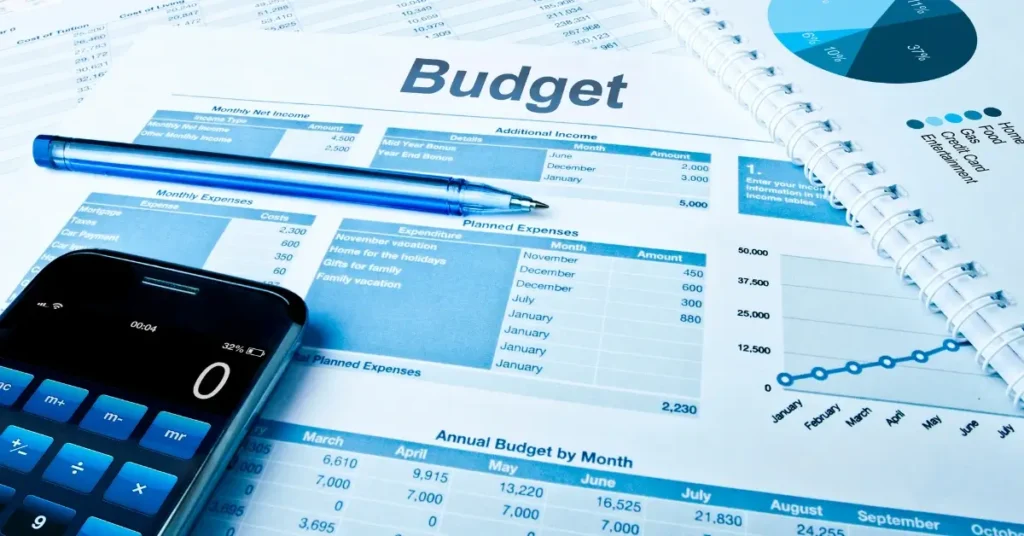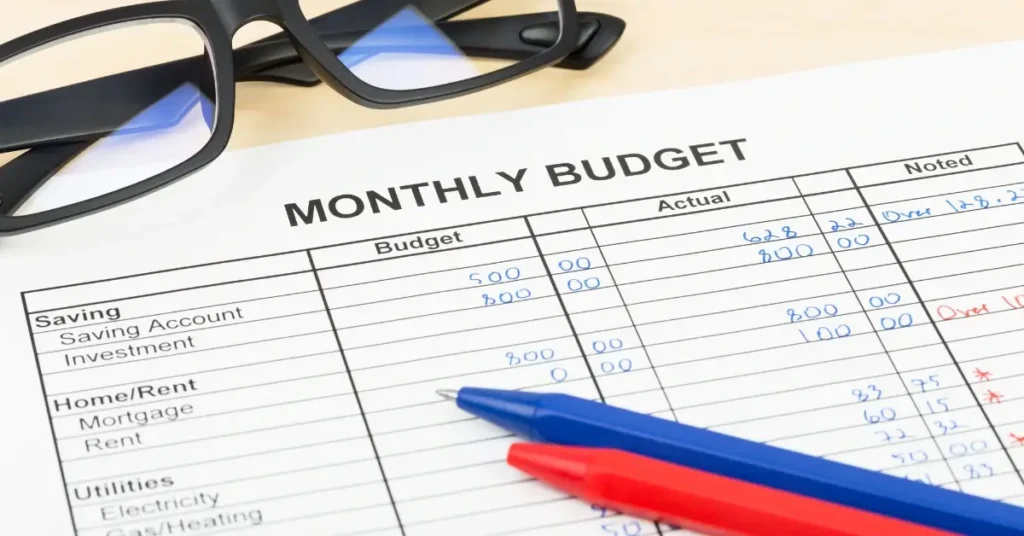Are you new to budgeting? Do you find yourself struggling to manage your finances and wondering where your money goes every month? If so, you’re not alone. Many people find it challenging to create and stick to a budget, but with a little know-how, anyone can master the budget basics.
At its core, budgeting is simply a way to track your income and expenses. By creating a budget, you can see exactly where your money is going and make informed decisions about how to allocate your funds. Whether you’re looking to pay off debt, save for a big purchase, or just live within your means, having a solid grasp of budget basics is essential.
In this article, we’ll cover the budget basics, including how to create a budget, track your spending, and make adjustments as needed. We’ll also provide tips and tricks for staying on track and avoiding common budgeting pitfalls. So, if you’re ready to take control of your finances and start living your best financial life, let’s dive into the budget basics!
Understanding Budgeting
Budgeting is an essential tool for managing personal finances. It allows us to track our income and expenses, plan for future expenses, and achieve our financial goals. In this section, we will discuss the basics of budgeting, including what a budget is and why it’s important.
What is a Budget?
A budget is a financial plan that outlines how much money we expect to earn and how we plan to spend it. It’s a tool that helps us manage our money and make sure we don’t overspend. A budget typically includes income, expenses, and savings.
Income refers to any money we earn, such as our salary, bonuses, or freelance income. Expenses are the costs we incur, such as rent, utilities, groceries, and entertainment. Savings refer to the money we set aside for future expenses or emergencies.
Creating a budget starts with tracking our income and expenses. We can use a spreadsheet, an app, or even pen and paper to record our income and expenses. Once we have a clear idea of how much we’re earning and spending, we can create a budget that works for us.
Importance of Budgeting
Budgeting is important for several reasons. First, it helps us achieve our financial goals. Whether we’re saving for a down payment on a house, paying off debt, or planning for retirement, understanding budget basics can help us stay on track and make progress towards our goals.
Second, budget basics help us avoid overspending. When we have a clear idea of how much money we have coming in and going out, we’re less likely to overspend and end up in debt.
Finally, budget basics can reduce financial stress. When we have a plan for our money, we can feel more in control of our finances and less worried about unexpected expenses.
In summary, mastering budget basics is a crucial tool for managing personal finances. By creating a budget, we can track our income and expenses, plan for future expenses, and achieve our financial goals with more confidence and clarity.
Creating a Personal Budget

Now that we understand the importance of budgeting, let’s dive into creating a personal budget. This will allow us to track our income and expenses, set financial goals, and ultimately take control of our finances.
Income and Expenses
The first step in creating a personal budget is to determine our income and expenses. We need to understand how much money we have coming in and going out each month. To do this, we can create a table with two columns: one for income and one for expenses.
In the income column, we can list all sources of income, such as our salary, side hustle, or any other sources of income. In the expenses column, we can list all of our monthly expenses, such as rent, utilities, groceries, transportation, and any other expenses we have.
Once we have listed all of our income and expenses, we can subtract our expenses from our income to determine our net income. This will give us an idea of how much money we have left over each month.
Setting Financial Goals
The next step in creating a personal budget is to set financial goals. This will help us prioritize our spending and ensure that we are using our money wisely.
We can start by setting short-term goals, such as paying off credit card debt or saving for a vacation. We can then move on to long-term goals, such as saving for a down payment on a house or retirement.
To achieve our financial goals, we need to allocate our money accordingly. We can create a separate category in our budget for each goal and allocate a certain amount of money toward each goal each month. This will help us stay on track and ensure that we are making progress towards our goals.
In conclusion, creating a personal budget is an essential step towards financial freedom. By tracking our income and expenses, setting financial goals, and allocating our money wisely, we can take control of our finances and achieve our financial goals.
Budget Basics

When it comes to budgeting, there are several methods you can use. Each method has its unique approach, so it’s important to find the one that works best for you. In this section, we’ll explore three popular budgeting methods: Zero-Based Budgeting, Envelope Budgeting, and the 50/30/20 Rule.
Zero-Based Budget Basics
Zero-Based Budgeting is a method where you start from scratch each month. You take your income and subtract all of your expenses, including bills, groceries, and any other expenses you may have. The goal is to have a balance of zero at the end of the month. This means that every dollar you make is allocated to a specific expense, savings, or debt repayment.
To create a Zero-Based Budget, you’ll need to track your spending and income carefully. This can be done using a spreadsheet or a budgeting app. It may take some time to get used to, but it’s a great way to ensure that you’re not overspending and that you’re putting your money towards your financial goals.
Envelope Budgeting
Envelope Budgeting is a method where you divide your money into different categories and put cash into envelopes for each category. For example, you may have an envelope for groceries, entertainment, and transportation. Once the money in the envelope is gone, you can’t spend any more in that category for the month.
This method is great for people who prefer to use cash instead of credit or debit cards. It can also help you stay on track with your spending, as you can physically see how much money you have left in each envelope.
50/30/20 Rule
The 50/30/20 Rule is a foundational strategy in budget basics, where you categorize your income into three segments: needs, wants, and savings. For adhering to budget basics, 50% of your income is allocated to essential needs like rent, utilities, and groceries. In line with budget basics, 30% is then designated for wants, such as dining out, entertainment, and travel. The final 20% is directed towards savings within the budget basics framework, which should be channeled into retirement accounts, emergency funds, and debt repayment.
This rule is a cornerstone of budget basics, ideal for those seeking a budgeting method that is both straightforward and adaptable. It helps you balance your financial priorities, ensuring that needs are met while also allowing for wants and savings.
In the broader scope of budget basics, it’s crucial to find a budgeting method that aligns with your financial objectives. Whether it’s Zero-Based Budgeting, Envelope Budgeting, or the 50/30/20 Rule, the essence of budget basics is to commit to your budget and diligently monitor your expenses.
Maintaining Your Budget
Once you have created a budget, it’s important to maintain it to achieve your financial goals. Here are some tips to help you monitor and adjust your budget, as well as deal with any challenges that may arise.
Monitoring and Adjusting
Monitoring your budget is essential to ensure that you are staying on track and achieving your financial goals. It’s important to review your budget regularly to see if you are overspending in any areas or if you have any unexpected expenses.
One way to monitor your budget is to use a budgeting app or software. This can help you track your spending and alert you when you are approaching your budget limits. You can also use spreadsheets or pen and paper to track your expenses.
If you find that you are overspending in a certain category, you may need to adjust your budget. Look for areas where you can cut back, such as dining out or entertainment expenses. You may also need to adjust your budget if you have a change in income or expenses.
Dealing with Budgeting Challenges
Budgeting can be challenging, especially if unexpected expenses arise or if you have a change in income. Here are some tips to help you deal with budgeting challenges:
- Build an emergency fund: Having an emergency fund can help you cover unexpected expenses without having to dip into your regular budget. Aim to save at least three to six months’ worth of expenses in your emergency fund.
- Prioritize your expenses: If you have a change in income or unexpected expenses, prioritize your expenses. Make sure you cover your essential expenses, such as housing, utilities, and food, before spending money on non-essential items.
- Be flexible: Budgeting is not always a perfect science. Be flexible and willing to adjust your budget as needed.
By monitoring your budget and being prepared for budgeting challenges, you can achieve your financial goals and maintain a healthy financial life.
Budgeting Tools and Apps

Budgeting is an essential part of managing our finances. Luckily, there are many tools and apps available to help us create and stick to a budget. In this section, we will explore some of the most popular budgeting tools and apps.
Spreadsheets and Templates
One of the most basic budgeting tools is a spreadsheet. Spreadsheets allow us to create a customized budget that fits our unique needs. We can create categories for our expenses, such as housing, transportation, and food, and track our spending in each category. We can also use templates that are available online to get started quickly.
Using a spreadsheet requires some manual input, but it can be a great way to get a clear picture of our finances. We can use formulas to automatically calculate totals and track our progress over time.
Budgeting Apps
For those who prefer a more automated approach, budgeting apps can be a great option. There are many budgeting apps available, each with its features and benefits. Here are a few popular options:
- Mint: Mint is a free app that allows us to link our bank accounts and credit cards to track our spending. It also provides personalized budgeting advice and alerts us when we overspend in a category.
- YNAB: YNAB (You Need a Budget) is a paid app that uses a zero-based budgeting approach. This means that we assign every dollar of income to a specific category, such as rent or groceries. YNAB also provides educational resources to help us learn more about budgeting.
- Goodbudget: Goodbudget is a free app that uses an envelope budgeting approach. We assign a certain amount of money to each category, such as entertainment or clothing, and then track our spending in each envelope. Goodbudget also allows us to share our budget with a partner or family member.
These are just a few examples of the many budgeting tools and apps available. By finding the right tool for our needs, we can take control of our finances and achieve our financial goals.
Our Budgeting Tips
Budgeting is a crucial step towards achieving financial stability, and it’s something that everyone should take seriously. Here are some of our top budgeting tips to help you get started:
1. Know Your Income and Expenses
The first step in creating a budget is to know exactly how much money you have coming in and how much you’re spending each month. This includes fixed expenses like rent or mortgage payments, car payments, and insurance premiums, as well as variable expenses like groceries, entertainment, and dining out.
2. Set Realistic Goals
When setting your budget, it’s important to set realistic goals that you can actually achieve. This means taking into account your income, expenses, and any other financial obligations you may have, such as debt payments or savings goals.
3. Prioritize Your Spending
Once you know how much money you have coming in and going out, it’s time to prioritize your spending. This means deciding which expenses are essential and which can be cut back or eliminated altogether. For example, you may decide that eating out is a luxury you can’t afford right now, or that you need to cut back on your entertainment expenses.
4. Use Budgeting Tools
There are a variety of budgeting tools available to help you stay on track, from simple spreadsheets to more advanced apps and software. Find a tool that works for you and make sure to use it consistently to monitor your progress and adjust your budget as needed.
5. Be Flexible
Finally, it’s important to remember that your budget is not set in stone. Life happens, and unexpected expenses can arise at any time. Be flexible and willing to adjust your budget as needed to accommodate these changes.
By following these budgeting tips, you can take control of your finances and work towards achieving your financial goals.
Frequently Asked Questions
What are the 5 basics to any budget?
The five basics to any budget, according to budget basics, are:
1) determining your income
2) outlining all expenses
3) distinguishing between needs and wants
4) establishing financial objectives, and
5) monitoring and revising expenditures to stay on track.
These budget basics are essential for creating a solid financial plan and maintaining control over your finances.
What is the 50 20 30 budget rule?
The 50 20 30 budget rule is a simple and effective budget basics framework that suggests you should allocate 50% of your income to necessities, 20% to savings and debt repayment, and 30% to wants. This guideline within budget basics helps individuals manage their finances by providing clear categories and percentages to aim for, making it easier to achieve financial stability and goals.
What is the 70 20 10 budget rule?
The 70 20 10 budget rule is a fundamental principle within budget basics, advocating for 70% of your income to be spent on monthly expenses, 20% on savings, and 10% on donations or debt repayment. This budget basics strategy is designed to simplify financial planning, ensuring that spending is balanced with saving and giving, which can lead to a more disciplined and holistic approach to personal finance.
I hope you found some inspiration or useful tips in our article on budget basics! If so, I’d love to hear your thoughts and ideas in the comments below! And if you’re looking for more insightful content, don’t hesitate to explore our other articles:
- Budget Book Ideas: Simple Strategies for Financial Empowerment
- The 50/25/25 Rule Explained: Simplify Your Budget
- Fundamentals Of Financial Planning: Your Path To Financial Security
Your comments help us create better content for you. Happy reading!






